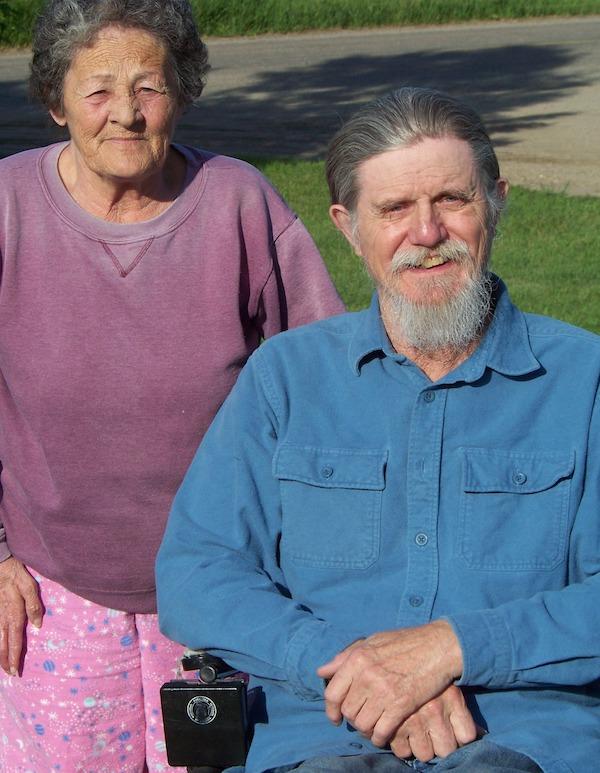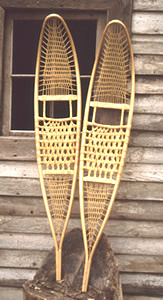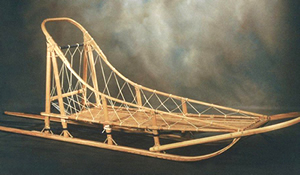Paul & Darlene Bergren

courtesy of Paul & Darlene Bergren
Bio
Paul Bergren built his first sled in 1978 and has since developed into one of the premier sled designers in the country, seamlessly blending aesthetics and function. Today, he and his wife Darlene run a sled-making business in Minot, North Dakota, and Paul's sleds -- widely respected for their craftsmanship -- are used by champion racers across the globe, including several champions of the grueling Iditarod Trail Sled Dog Race in Alaska. Paul, from Bersford, South Dakota, met Darlene while stationed with the Air Force in her hometown of Minot, North Dakota. The two married in 1964 and have remained in Minot ever since. They raised five children, and Paul frequently made snowshoes to outfit his family on trapping expeditions. Paul's interest in dogsleds began when one of his children asked for a snowmobile to use while trapping. Instead, the family got a dog, and Paul made a sled; soon enough the entire family was hooked on dog-sled racing. As they attended more and more races, Paul's interest in sled design grew. He began building sleds full-time after an accident left Paul unable to pursue his original career as a farrier and horse-shoer. The sleds are handmade of steamed and bent white ash that is laminated for durability and lightness and are stitched with rawhide in an aesthetically pleasing pattern. The Bergrens share their craft with countless others through apprentice programs and school residencies, working with groups such as the North Dakota Council on the Arts traditional arts apprenticeship program and the North Dakota School for the Deaf. Additionally, they have worked with Boy Scout and Girl Scout groups and made presentations at craft festivals and workshops throughout the northern United States. "Paul and Darlene have become legends in their medium of traditional sled making, and in their generosity of sharing those talents with others who want to learn," noted Robin and Paul Carlson, Norwegian-American folk artists, in their nomination support letter. "They are persistent not only in their journey to maintain excellence and authenticity in the traditions of their craft, but also in their earnestness to share their knowledge with others."
 |  | |
Photos by Jim Johnson, courtesy of the North Dakota Council on the Arts.
Interview with Paul and Darlene Bergren by Josephine Reed October 4, 2012 Edited by Liz Auclair NEA: I guess the biggest question I have is what came first, the dog or the sled? Paul Bergren: The need. The need came first. Terry [my son] was into trapping and wanted a snow mobile. I am not a mechanic and so I decided that it would probably be better to have one good sled dog and a sled. It would start every morning and I wouldn't have to work on it. So that's kind of what we did. NEA: And had you been a builder? Had you been a carpenter? Paul Bergren: No, but I had done a lot of different things. I designed our house. NEA: How did you design the house? Paul Bergren: Well, I just sat down with a piece of paper and figured out what we wanted and drew it. That was all. NEA: So clearly it's something intuitive with you. Paul Bergren: I think that our family is very artistic. I know my mother is and so are my brothers and sisters, so it's kind of there. We can see something and create it. I know my oldest boy Terry has the same gift. NEA: Can you tell me about the first sled that you built? How did it come together? Paul Bergren: Yeah, that was kind of interesting. Being out on the plains there aren't many good trees for lumber, so I did a lot of looking for material to make the runners out of. I did find finally some pieces of oak over in the eastern part of the state in a sawmill and brought them home. The rest of the sled was made out of broken hockey sticks. We tied them together with rawhide, and it was crude but it was very tough and it stayed together. It just kind of went on from there. One of my friends had a son that wanted a sled, and so we built him one and it just kind of took off that way. NEA: Out of hockey sticks? Paul Bergren: Oh yeah, that was out of hockey sticks too, and what was leftover of the board that I had found. And then we started looking for good material. NEA: Do you use a steam box? Paul Bergren: Yes, I do. We steam bend everything. The original sleds were all one-piece material. Very traditional. Our newer sleds of course are all laminated and parts of them are fiberglass-wrapped. The reason they're laminated is that I can duplicate every piece if I have to because other people buy them. They might be in California or wherever, and we might have to send them a part. That's why we've got to be able to duplicate exactly the shape of it, and laminating is the only thing that will allow that. Whereas [when] you steam bend a piece of wood, every piece bends differently, so you never end up with the same part exactly. They're close but they're not exact. NEA: Can you explain what steam bending is? Paul Bergren: We would put a piece of wood say in the steam tube or steam box and then close the end of it, force steam up into the box, boil water in a can, and force the steam up into the box. The rule of thumb is an inch an hour. If it was an inch thick you'd steam it for an hour. NEA: What does the steaming allow you to do? Paul Bergren: What the steaming does it changes the wood from something that's stick to something that they call "plastic" in the industry. It becomes very bendable, very moldable. Chemically I can't tell you exactly what takes place in the wood. All I know is there are connective tissues, and they turn loose and allow it to bend. And I know that if the material is soaked long in water you lose this material that allows it to bend, and it becomes rigid. Not only that, but it can become hardened by the sun and the air. You have to be careful what you buy. The material we buy is all air-dried of course. It can't be kilned -- it doesn't bend well, it will break. Because they've cooked that material that's in there, and it doesn't allow the wood to bend anymore. It destroys it for bending for a runner or something like that. We just had a lot of fun playing with it. We've made all kinds of stuff and made snowshoes and so forth. Ash is a medium hardwood, medium elasticity, so it's springy. And it's probably one of the nicest things there is to bend. It's fibrous. It doesn't shear when it breaks. It shreds. It doesn't just snap off. So when it starts to deteriorate and break, it starts to shred and it gives you a warning that it's coming apart. So if I was in the middle of nowhere with a sled, I could wrap it with something and get back in with it. Where if it was maybe a piece of oak it might just snap off. NEA: You started doing this basically as a hobby. How did it transition into being a full-time job? Paul Bergren: I was at a dog-sled race in Manitoba. We were staying with some friends, and some drivers stopped there on their way back from the Pas race in Manitoba, which is a big three-day race. One of their dogs had hurt itself the first day, so they came back down to Winnipeg to race there. He was highly ranked in the International Sled Dog Racing Association, and probably I think the largest medal winner of the association, him and his wife together. And we were sitting there in his den chatting, and he said, "I understand you build sleds." And I said, "Yeah." I mean, I was nobody in the sport. And he said, "Well, we'll have to get together." And he said, "If I like what you make, I'll promote them for you." Two years later we finally got together. We met at a race and he made the same proposition and told me what he wanted and so we created that for him. It started to evolve from there. NEA: What had you been doing before you made sleds full time? Paul Bergren: I was a farrier. A farrier is a horseshoer. I did a lot of corrective shoeing and a lot of specialty work. That was my art form -- I made all my shoes and tools and everything also. So what we talked about earlier, of being able to envision something, [I] could look at a horse's foot and see that it was crooked and what was wrong with it. That became my art form. People used to buy horses so I could fix them. It got a little hairy sometimes because they didn't always buy something you could fix. Sometimes they were a nightmare. NEA: How did you get into dog-sled racing? Paul Bergren: I used to cowboy with the horse industry -- we team roped and did ranch work and did all kinds of stuff for fun. That was always in the summer so we started looking for something to do in the wintertime that was fun. We happened to meet some folks that were into dog-sled racing, and we kind of picked their brain and found out what all was going on and where it was happening. Minnesota was the hotbed of dog-sled racing at that time in our area. They had races with up to 250 entries at one time. It's a lot of people. NEA: How many dogs did you race with when you first started out? Paul Bergren: We started off with small teams of about three dogs. In fact, we borrowed dogs from people. We were looking for a specific design of dog. Most of the registered dogs were too -- I’m going to call them "cobby" -- short and weren't athletically built enough. They didn't cover enough ground in each stride for what we were looking for and so I went looking for a female to raise pups out of. We had a man in a town south of where we lived that had some coyote dogs, coyote hounds. And they were a hybrid cross for what he had. They were Irish Wolfhound and Scottish Deerhound and Greyhound crosses. Real leggy, long-made dogs but they didn't have any hair on them. They were real short nappy-haired dogs. And so I bought a female from him and we did a cross with huskies on her, and they were awesome. She was extremely intelligent and very talented dog herself. And the male we used was very, very athletic also. Her first litter was a dozen puppies. And all of them ran. All of them were excellent. Most of them were leaders. Terry won the International Bowl Medal in three-dog class running one of the males in front and his half-sister. It took us three years to find another dog that could run as fast as those two pups ran. So it was a process of trying to fit dogs into that team. We finally found one, and in '88 he won the gold. He came over and ran in Saranac Lake, New York, and won gold. NEA: How does it work? Would you kind of build the sled to suit that dog? Paul Bergren: Basically we tried to build the sled for the situation, for the type of race that it was being used and for the individual's type. Some people like real stiff sleds, no give at all. It was more of a security blanket than anything else. And some people, like Terry, like a sled that was very flexible so the framing and all the joints would bend. If you let go of it, it would lay down. He liked it that loose. You could make a sled that would work for the individual. NEA: From the beginning you wanted to use traditional materials, traditional methods of building. Why was that? Paul Bergren: Because I am a traditionalist. That came about from my horseshoeing. I made my own shoes -- punched the nail holes in them, creased them, folded them. NEA: Darlene, did you get involved in sled-building from the get-go? Darlene Bergren: Oh yes, from the very beginning. NEA: You liked it a lot. Darlene Bergren: Yeah, I sure did. NEA: Have you been building stuff beforehand as well? Darlene Bergren: No, I had not. I have a hard time looking at something and seeing it. So I don't have the gift that he does or my kids. The kids all have it. NEA: But if somebody gives you the design you're good to go. Darlene Bergren: Pretty much so, yeah. NEA: So you both ran the business. Was there a business for traditional sledding? Darlene Bergren: Yeah, there sure was. And we've got sleds all over the world: Japan, England, Germany. NEA: Did you race too? Darlene Bergren: I did a little bit. I more helped to harness and get to the shoot. The racing shoot -- starting line. I'm not a real good sled rider. I spent a lot of time on the ground being dragged. But I liked it. NEA: Paul, you liked sledding itself aside from the building and the dog part? Paul Bergren: Absolutely. I enjoyed the training of them. I like when they were pups. NEA: How do you train them? Paul Bergren: It's a long process but we start off by exercising puppies. We've got a lot of countryside in our area and we'd just go up and drop the female out and her pups and drive off with the truck and she'd lope along behind the vehicle and just by watching what her puppies did you could find dogs that had an attitude, dogs that were fast, dogs that didn't give a hoot. And so that's kind of what you did. You could see what they were mentally and physically also. The first one to the truck had usually the best attitude and was usually the fastest one. NEA: So it was about reading the dogs too. Paul Bergren: Absolutely. And if you've got one that's looking off over here, and he runs over and sniffs on a weed, you know darn good and well it's going to take you forever to get into his head and try to train him to do something. NEA: What is racing like? What does it feel like when you're out there in the snow on the sled with the dogs? Paul Bergren: It's exhilarating. I don't think I've ever found anybody that's ever got on the back of a sled or rode in one that didn't want to do it again. It's an experience of speed and excitement, tranquility. It's peaceful motion. The dog runs in a rhythm and the team gets in a rhythm and they just float across the snow. And it's quiet. Every once in a while maybe a dog will bark or yap, maybe just out of excitement or maybe just as they start. Other than that it's dead silence. It's just a thrill. And of course if you get to doing this continually it kind of gets in your blood. NEA: Now, did you teach people how to do build sleds? Paul Bergren: Well, we started a lot of people [in learning the craft]. We had very good friends that wanted to know how to do this and get started in the sport. We also got several grants to teach sled building and snow shoe [building]. And of course we went to schools. Terry used to go to the schools and give rides to the kids. I think probably one of our most rewarding [experiences] for ourselves and [the students] also I hope, we went to the school for the deaf in North Dakota and we did a teaching and sled building program there and it was just really unique. It was really exciting to work with them.

